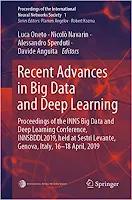Recent Advances in Big Data and Deep Learning: Proceedings of the 2019 INNS Conference
Luca Oneto, Nicolò Navarin, Alessandro Sperduti, Davide Anguita ... 403 pages - Publisher: Springer; (April, 2019) ... Language: English - ASIN: B07QD8SLQ4 by Amazon.
This book presents the original articles that have been accepted in the 2019 INNS Big Data and Deep Learning (INNS BDDL) international conference, a major event for researchers in the field of artificial neural networks, big data and related topics, organized by the International Neural Network Society and hosted by the University of Genoa. In 2019 INNS BDDL has been held in Sestri Levante (Italy) from April 16 to April 18. More than 80 researchers from 20 countries participated in the INNS BDDL in April 2019. In addition to regular sessions, INNS BDDL welcomed around 40 oral communications, 6 tutorials have been presented together with 4 invited plenary speakers. This book covers a broad range of topics in big data and deep learning, from theoretical aspects to state-of-the-art applications. This book is directed to both Ph.D. students and Researchers in the field in order to provide a general picture of the state-of-the-art on the topics addressed by the conference.
This book presents the original articles that have been accepted in the 2019 INNS Big Data and Deep Learning (INNS BDDL) international conference, a major event for researchers in the field of artificial neural networks, big data and related topics, organized by the International Neural Network Society and hosted by the University of Genoa. In 2019 INNS BDDL has been held in Sestri Levante (Italy) from April 16 to April 18. More than 80 researchers from 20 countries participated in the INNS BDDL in April 2019. In addition to regular sessions, INNS BDDL welcomed around 40 oral communications, 6 tutorials have been presented together with 4 invited plenary speakers. This book covers a broad range of topics in big data and deep learning, from theoretical aspects to state-of-the-art applications. This book is directed to both Ph.D. students and Researchers in the field in order to provide a general picture of the state-of-the-art on the topics addressed by the conference.













